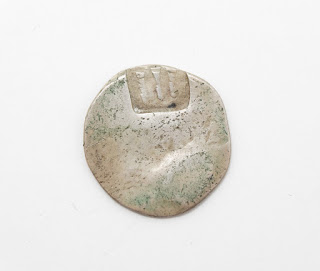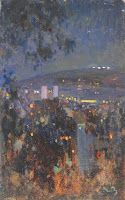Visit us at www.ninecarolineantiques.com for updated blog content
View this blog entry on the updated Nine Caroline Antiques website
Today we take a look at the fascinating 1652 NE Threepence silvercoin.
In 1652, the first metallic currency was struck in England’s
American colonies. During this time period, the American colonies were
suffering from a currency shortage. The English government had banned the
export of its silver coins to its own colonies. England was experiencing a coin
shortage itself and wanted to keep its small coin denominations at home, but
the government also believed that the colonies should be sending wealth to England (certainly not the other way
around). Even if the English government had wanted to send coins to the
colonies, they were unable to do so until they had solved their own currency
problems. Of the coins in circulation in the colonies, many were counterfeits.
The local businesses struggled to maintain a healthy economy, particularly in
bustling port towns like Boston which was already engaging in a healthy
import/export trade by the mid 1600s.
The colony of Massachusetts Bay, laboring under the small
change coin shortage, resolved to solve the problem on its own. Without bothering
to ask approval from the English government, the General Court of Massachusetts
Bay charged silversmiths John Hull and Robert Sanderson to create shilling, sixpence,
and threepence coins.
The first coins struck in America were made by an illicit mint
in Boston, Massachusetts. The coins were struck in silver and are known as the “NE”
or “New England” type coins. The coins were struck for only three months in
1652 and are exceedingly rare. The coins were simple, irregularly shaped discs
with no decoration or date. One side bore the punched initials of “NE” for New
England, while the reverse bore the denomination on the reverse in Roman
numerals (III for threepence, VI for sixpence, XII for shilling).
Only one specimen of the 1652 NE Threepence coin is known to
exist, and is held in the collections of the Massachusetts Historical Society,
though every denomination of the surviving 1652 New England coins is a genuine
rarity.
We recently came across an interesting 19thcentury facsimile coin designed after the extraordinarily rare 1652 New England Threepence. The 1652 NE coins were already known and valued as scarce by this
time. In the mid 19th century, the hobby of coin collecting exploded
into wild popularity. The surge in interest in coins led to the eternal
collector’s dilemma: there are only a very limited number of rare coins, and
passionate collectors may never see, let alone own, the most interesting and
exciting examples in their field of interest. While counterfeiting coins for
use as currency has existed as long as currency has itself, the coin collecting
boom now saw an increase in the creation of facsimiles of rare and desirable
coins. Some of these facsimiles were honestly sold as interesting copies for the
passionate and knowledgeable collector who simply wanted a version of a rarity
for his own enjoyment. However, some unscrupulous people would sell the
facsimiles as authentic, duping their trusting customers.
The 1652 NE Threepence coin is a fascinating glimpse into
the history of the American colonies. Our version of this coin can be found in our store.
Or, click here to visit our store and see everything currently available!









































